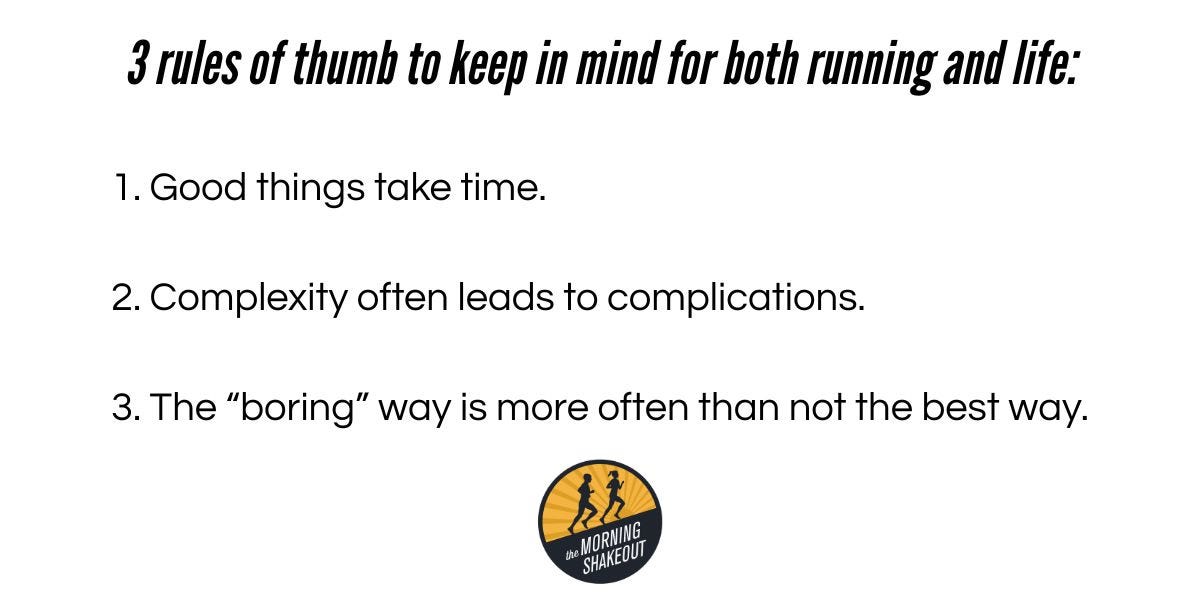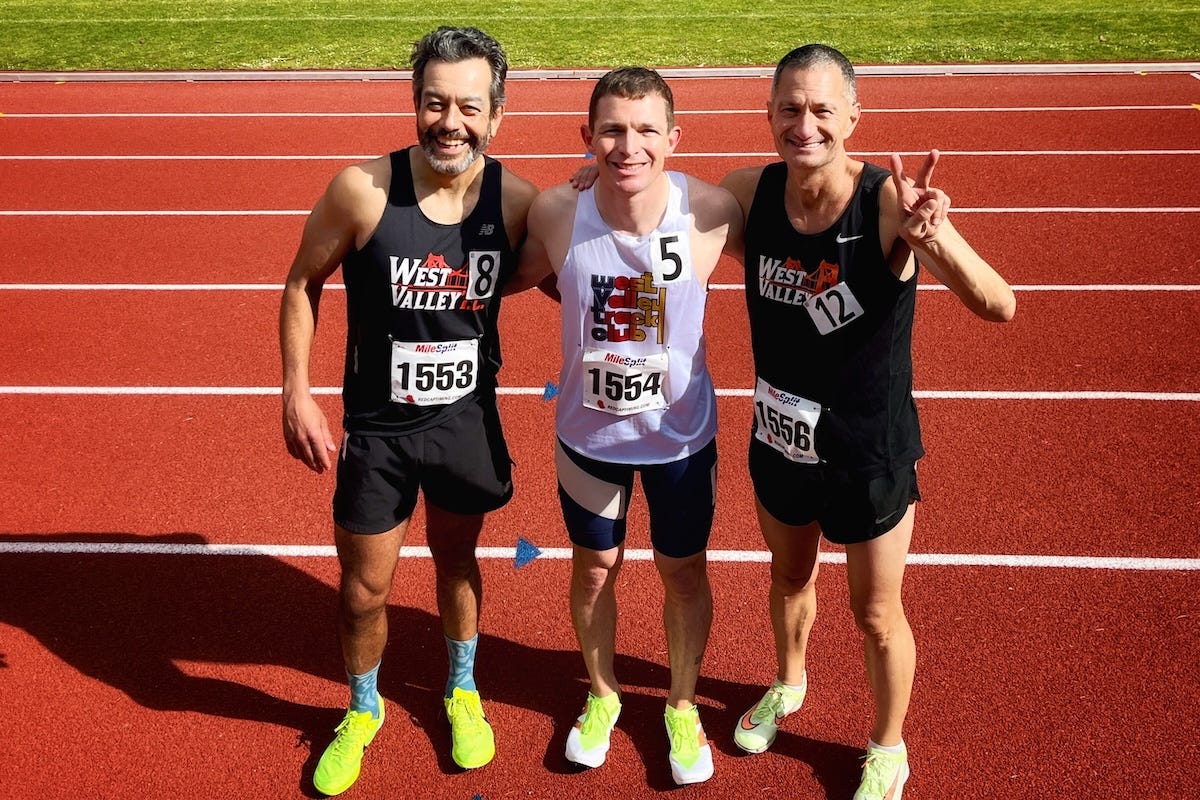the morning shakeout | issue 491
A few rules of thumb for running and life, why social media might be making you slower, some thoughts on Grand Slam Track, and a lot more.
Good morning! This past weekend I did something I haven’t done in over 20 years and raced twice in as many days. The last time I did this was in college, when competing two days in a row at a championship was not an uncommon occurrence. On Friday afternoon, I lined up for Heat 12 of the 1500m at the Mike Fanelli Track Classic in San Francisco, and then contested the Masters Mile on Saturday morning at the same meet. Why? If I had to sum it up in two words, it would be excitement and curiosity—a couple of crucial elements that were missing from my running last fall, but that I’ve since rediscovered and been nurturing over the past few months. I was fired up for a 3-¾ lap gut check against a bunch of college kids who weren’t even half my age, and eager to see if I could come back the next day and run fast enough to help one of my West Valley Track Club teammates hit his goal.
On Friday I knew the race would go out harder than I was ready for and one lap in I was DFL as expected, passing through 400 meters in 66-ish seconds. With two laps to go I started moving up and by the time we hit the bell I was in seventh or eighth. I picked up 2-3 more spots on the final backstretch and thought for a second that I might be able to sneak into the top three. It was high-speed chess and I couldn’t have been having more fun. Then, with 150m to go, a piano fell out of the sky and onto my back, causing me to lose some steam (and a couple places) down the homestretch. I finished 8th in 4:11.95. Before the race I thought 4:12 would be a great day, so no complaints at all. Upon crossing the finish line I stumbled onto the infield in a hypoxic state, trying to remember where I had set my stuff, my legs and lungs engulfed in a bonfire of effort. It was the best worst feeling in the world, which sounds absurd, but if you’ve ever run yourself completely ragged you know exactly what I mean. One must imagine Mario happy.
The next day I came back for the more age-appropriate Masters Mile in which my goal was to run 70-second laps for as long as possible to help out my teammate, Mark. We came through the first circuit more or less right on pace and I knew if Mark was feeling good that he’d probably go by me somewhere around halfway. With two to go, he was right on my shoulder and we were pretty well clear of third place by that point. Mark didn’t try to make a pass so I focused on maintaining my rhythm as I continued to lead on the backstretch. As we approached a lap-and-a-half to go I felt some separation for the first time. The pace hadn’t picked up so I knew Mark must not have been feeling all that great. I just tried to stay smooth and in control coming into the home stretch for the next-to-last time. At the bell I saw 3:33 on the clock and didn’t feel any pressure. I knew the race was mine if I didn’t do anything stupid, so I focused on staying relaxed and maintaining good form for the final quarter mile. I was able to do just that, crossing the finish line in 4:43.91 to win by nearly 8 seconds. After exchanging fist bumps with my fellow competitors I made my way across the infield once again, not quite in the same state of absolute exhaustion I found myself in 17 hours before, but happy just the same—and maybe even a little more curious and excited to see what else might be possible.

Quick Splits
— A common issue that comes up in my coaching practice is getting athletes to detach from their devices prior to training and racing. Much of this has to do with trying to eliminate distraction, i.e. their minds are somewhere else when they should be focusing on the upcoming task at hand, but sometimes it has to do with managing stress and cognitive fatigue that results from essentially being overstimulated all the time. In his latest column for Outside, Alex Hutchinson analyzes a recent study that “demonstrated that using social media on smartphones immediately before training sessions caused mental fatigue and impaired AE in young volleyball athletes.” Now, you could take the adjectives “young volleyball” out of the previous statement and it would still hold true. Hutchinson looks back at some past studies linking social media use to well-being and performance, and while you can nitpick how much usage is too much, acute effects versus chronic ones, or if social media usage affects power and endurance outputs differently, I think all of that misses the forest for the trees: it is inarguable in 2025 that smartphone—and more specifically, social media—usage has a net negative effect on performance and performance outcomes. I’ve observed this firsthand with my own athletes over the past 10 or so years and, because I am by no means holier than thou, I’ve experienced this myself more times than I care to admit as well. Smartphones and many of the apps that are on them are designed to be addicting and intoxicating, and all that “mindless” scrolling drains the brain in ways that very few things can. So what are we to do about it? I advise staying off your phones/social media for at least the 30 minutes before your run, workout, or race (or even longer if you can get away with it). And, in the week or two (or more!) before a big race, limit or eliminate your social media usage. Remove the apps from your phone. It will feel weird and uncomfortable at first but with enough time it will reduce stress and cognitive load in general, allowing you to adequately restock those reserves before taking the start line.
— Buzz Burrell is a running industry stalwart who’s done a lot of interesting things over the years but is perhaps best known for two: growing Ultimate Direction into one of the hydration category’s leading brands and cofounding the Fastest Known Time website, which helped popularize the current FKT movement. But like Walt Whitman, the 73-year-old Burrell contains multitudes, and
recently captured some of those in this interview for her newsletter, Mountain Running & Living. I really appreciated what Burrell had to say about how being a multi-sport athlete helps contribute to overall longevity, as well as how a cardiac close-call in 2023 changed his perspective on life. “Now is the time. Whatever you want to do or be in life, now is the best time. Maybe the only time,” he says. “Mortality is very interesting. We never think about it, which sounds dumb, since it’s obvious we all are going to die. But also very correct, because it is our genetic mandate to live, thrive, and survive, and thinking about anything else is a distraction. Until one does almost die. Then it can go two ways: (1) ‘Whoa, life is dangerous, we have to be really careful, take the best care of ourselves possible. Let’s buy an even bigger house and fill it with stuff from our past, because our future isn’t interesting.’ Or, (2) ‘Whoa, life is precious. I’m going to die soon, absolutely no getting around it, so I’m really stimulated to live, grow, experience.’”— I wasn’t able to watch too closely but Grand Slam Track had my attention at different points of the weekend. Mostly I was intrigued by the format, with many athletes needing to run in an “off” event as they competed twice over the course of three days with the highest point total across both events determining the winner, while simultaneously excited that this was the first of four meets between now and the end of June, setting up rivalries and storylines that should be fun to follow for the next couple of months (and beyond, if we look ahead to the world championships in mid-September). The races were tactical, as you’d expect in this kind of format, which contributed to some interesting results, such as Grant Fisher leading a 1-2-3 American finish in the men’s 5000m on Friday (which closed in 51 seconds!), and decisions, like Fisher not going for the win in the 3000m on Sunday, knowing the $100K prize was his as long as he finished no worse than third. So does GST as a league have legs? No doubt. Money clearly talks (i.e. attracts big names) and head-to-head racing is really fun to watch. But can it burst through the track and field fan bubble and reach a bigger audience that cares enough to fill stadiums and tune in consistently to broadcasts? Time will tell. Fans, and potential fans, will need a reason to continue to watch and invest money in the product. To use a baseball analogy, if I may, in its first at-bat I think Grand Slam Track hit a solid single. They got on base in Jamaica and it garnered some attention. Not a bad start. But this is going to be a long game and the next few times up to the plate are crucial. The competition, intrigue, and drama have to build with—and in between—each meet. And while they certainly don’t need to knock it out of the park every time, GST can ill afford not to get on base right out of the gate if it eventually wants to live up to its name. Otherwise, it’ll be a big swing and a miss.
— Tracy Chapman has long been one of my favorite musicians. More accurately, perhaps, she’s one of my favorite writers and just so happens to put a lyrical spin on the stories she tells through her music. She’s also famously reclusive and rarely does any media, so you can imagine my delight when this interview with Lindsay Zoladz of The New York Times dropped last week. The reason? Chapman just reissued a vinyl version of her multiplatinum self-titled debut album, which came out 37 years ago, so she was happy to talk. One of my favorite parts of the interview was when she spoke about her band, and how they came together to help her when she performed her hit “Fast Car” at the Grammys last year with Luke Combs. Chapman, who hadn’t worked with them in years because she stopped touring, remarked how she wept when she walked into the rehearsal space ahead of the show. “I don’t remember the last time I toured. And when you don’t tour, you also don’t have crew,” she said. “But the awesome thing was that everyone I called to help with this — they showed up. And so I was weeping, truthfully, when I walked into the rehearsal space…I’ve had some guys that I’ve worked with through the years, for sound and lights, and they all showed up. So, emotionally, that was really something.” Reading that was a reminder that life is not necessarily about what you do, it’s who you do it with. It’s about connection, not destination. Success is when your people show up for you, whenever you need them.
— After linking to that Tracy Chapman interview I couldn’t not share what is perhaps my favorite performance off her debut album, this live rendition of “Talkin’ About a Revolution” from 1988. Chapman, just 24 years old in this video, was singing as part of Nelson Mandela’s 70th birthday concert. And, with nothing more than a guitar and the words coming out of her mouth, she holds a packed stadium at rapt attention. She just has a presence that is hard to describe. Jaw-dropping, really.
— From the archives (Issue 439, 1 year ago this week): It has nothing to do with running but this profile of Iowa’s Caitlin Clark by ESPN’s Wright Thompson is one of the best longform stories of 2024. (n.b. I am confident this statement will hold up 9 months from now.) Thompson, as only he can, paints a full picture of an abnormally intense competitor navigating the challenges of growing superstardom and all the external pressures that come with it, while simultaneously trying to figure out who she is as a person, teammate, and leader at the ripe old age of 22. “Modern fame is a radioactive thing that corrodes everything it touches and consumes some people completely,” he writes. “Human beings are designed to live in small tribes, where the most important part of everyday life revolves around direct interactions. That vital way of being is undercut again and again by fame. It really messes some people up. Caitlin has been fighting to feel and be and be seen as human since high school, even as she has strived for things that can only be described as superhuman.”
A big thank you to Tracksmith for supporting my work in 2025. My favorite new shoe of the year so far is their recently released Eliot Racer, which combines a carbon plate with a soft yet supportive drop-in midsole for a fast, responsive, and stylish ride. (Men’s sizes here, women’s sizes here.) I’ve been running in it for a few weeks now and it was good to go out of the box for a tempo run: an accommodating upper for my fat forefoot, a midsole combination that provides awesome comfort and pop underfoot, and a sleek aesthetic that stands out amongst a class of shoes that often looks overbuilt. Every detail was thoughtfully considered. If you pick up a pair of Eliot Racers, or buy anything on Tracksmith.com between now and the end of May for that matter, use the code “MarioSpring” for $20 off an order of $100 or more. (Note: the code is good for one use between now and the end of May.)
Are you going to be in Boston on marathon weekend? Join me at the Trackhouse on Saturday, April 19 at 9 AM for my favorite event of marathon weekend—the morning shakeout! We’ll head out along the Charles for an easy 3-5 miles followed by coffee and casual conversation. The event is free but please register here so we can get an idea of how many people to expect. Hope to see you there!
Workout of the Week: Descend the Ladder
While half marathons and marathons are a matter of resisting fatigue during the later miles, 5K and 10K racing is like fighting off a firestorm for the final third of the race. No matter how comfortable the early pace may feel to you, about two thirds of the way into a fast 5K or 10K a spark suddenly catches fire and starts to spread rapidly as your legs begin to lock up and your stride shortens ever so slightly. Your quads are screaming at you to stop and your upper body tenses up as you seemingly start going backward while you struggle to maintain pace or stick with the runner in front of you. There’s nothing wrong with any of this at the end of a hard race, of course—it simply means that you’re doing it right! While your muscles are inevitably going to catch fire toward the end of a competitive 5K or 10K effort, you can train your body to slow down the burn and better handle the demands of the race in training. One of my favorite ways to do this is with the descending ladder workout. Here are the details.
The bottom line.
"Everyone heading for the top—but tell me how far is it from the bottom?
— Peter Tosh, Jamaican reggae musician, in “Equal Rights”
That’s it for Issue 491. If you’d like to support the shakeout, please forward this email to someone who might enjoy it or post the web link in a high traffic area of the internet where others can check it out. (And if you’re seeing this newsletter for the first time and want to receive it for yourself first thing every Tuesday morning, you can subscribe right here.)
Thanks for reading,
Mario







Hi Mario,
Looking forward to meeting you in Boston, probably at Marathon Sports, since I’ll be running the 5k and might not make it to Tracksmith. I’m really enjoying reading your morning shakeout. In my early running days, Nate Jenkins was giving me valuable advice. I feel my biggest challenge is the mental side of marathoning, specifically the self belief after all the hard training is done.
Love the idea of going smartphone-free before a big race! Coming from you, someone who thrives here in this space, that says a lot. I read somewhere, maybe Steve Magness, that a good coach wants to do away with his job because his athletes are independent. Since I'm self-coached right now, I normally rely on getting ideas from runners/coaches like you here, so this is a good reminder to look inward at that point. About Tracksmith, I wanted to share that I sent them a proposal to be a Southwest field rep, so wish me luck!